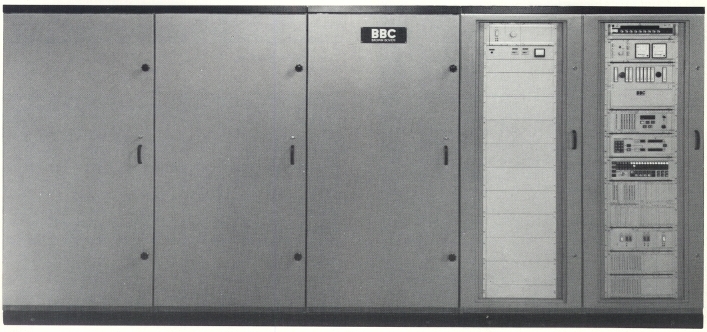| GENERAL DESCRIPTION |
 A newly developed 500 kW short-wave transmitter is the latest addition to BBC's family of modern short-wave and medium-wave transmitters with ratings from 100 to 300 kW. The most notable features of the new transmitter are:
A newly developed 500 kW short-wave transmitter is the latest addition to BBC's family of modern short-wave and medium-wave transmitters with ratings from 100 to 300 kW. The most notable features of the new transmitter are:| TECHNICAL SPECIFICATIONS | |
| Power output | 500 kW |
| Operating mode | A3 |
| Carrier frequency range | - standard: 5.9 to 26.1 MHz - with accessory: 3.9 to 26.1 MHz |
| Output impedance | 50 ohms, unbalanced - with balun: 200 ohms/300 ohms, balanced |
| Permitted VSWR | 1:1.7 |
| Time to change frequency | Average approx. 20 s, max. 60 s |
| Harmonics | Complies with International Telecommunication Union (ITU) Radio Regulation, Edition 1982 Appendix 8, Regulation 1982 |
| AF frequency range | - PSM modulator: 50 Hz to 7.5 kHz - Push-pull class B modulator: 50 Hz to 10 kHz |
| AF qualities | Complies with international standards |
| Mains connection | 3 ph/3 kV to 24 kV |
| Mains frequency | 50 or 60 Hz |
| Overall efficiency in program service | - with PSM modulator: >70% - with push-pull class B modulator: >65% |
| Power factor | >0.9 |
| Permitted ambient temperature | - standard: 1°C to 45°C - with air-flap accessory: -20°C to +45°C |
| Required floor space | - with PSM modulator: Approx. 46 m2 - with push-pull class B modulator: Approx. 65 m2 |
| Specifications may change without notice | |
| TUBE COMPLEMENT | |||
| RF stages | AF stages and modulator | ||
| Number | Type | Number | Type |
| 1 | CQK 650-1 | 2 | CQK 200-3 |
| 1 | CTK 12-1 | ||
| THIS TYPE OF TRANSMITTER IS INSTALLED IN THE FOLLOWING COUNTRIES | |||||
| ITU | Country | ITU | Country | ||
| BIH | BOSNIA-HERCEGOVINA | FIN | FINLAND | ||
| D | GERMANY | IND | INDIA | ||
| IRN | IRAN | IRQ | IRAQ | ||
| JOR | JORDAN | KWT | KUWAIT | ||
| LBY | LIBYA | NIG | NIGERIA | ||
| S | SWEDEN | SUI | SWITZERLAND | ||
| TUR | TURKEY | UAE | UNITED ARAB EMIRATES | ||
| USA | USA | CVA | VATICAN CITY | ||